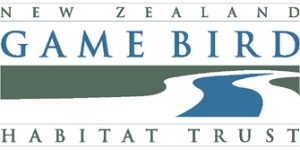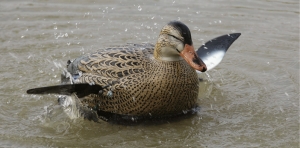Displaying items by tag: Game Bird hunting
What the Game Bird Habitat Trust does
The Game Bird Habitat Trust was established by the Wildlife Act 1953 and must comply with the Crown Entities Act 2004 as per the 4th Schedule of the Public Finance Act 1989.
There are a range of functions set out in section 44D of the Wildlife Act, but primarily it is to improve New Zealand’s game bird habitat and its secondary
function is to improve the habitat of other wildlife.
This is achieved by identifying, evaluating and funding areas of New Zealand worthy of protection, restoration, or creation of suitable habitat. The trust is also charged with recommending the production, fees and species to be depicted on the following year’s Game Bird Habitat Stamp to the Fish and Game Council.
The bulk of its funding is provided through the Game Bird Habitat Stamp programme. The Habitat Trust has charitable trust status but is yet to receive any significant donations. Additional funding via corporate partnerships is being explored.
The trust is the sole public body or charitable trust dedicated to providing
financial backing for game bird conservation in New Zealand. It has been influential in supporting many projects over the years by recognising that often all that is needed to enable a project to go ahead is a modest grant.
The trustees recognise habitat protection as one of the most significant drivers
of positive change for New Zealand’s wildlife.
Farmland ponds across New Zealand are important habitat for wildlife in
the agricultural landscape. Healthy networks of these ponds, at different stages of their lives, help wildlife species to move around farmland habitats.
As habitat fragmentation continues to increase, they are more important than ever. Without them, many species would struggle to survive.
The trust is working to increase the number of ponds on rural land by helping landowners restore existing overgrown ponds and create new ones.
The Para Wetland in Marlborough is one of the most significant projects funded by the trust and has become its “flagship” project over recent years. The trust has been able to assist the Nelson/ Marlborough Fish and Game Council develop and implement a detailed management and development plan, promote public interest and mobilise support from other funders.
Other major projects supported by the trust include the Takitakitoa Wetland and the Underwood Wetland near Dargaville. The trustees are looking
at other potential significant projects including the JK Donald Block on the north-eastern edge of Lake Wairarapa.
The trust prides itself on punching above its weight in terms of its contributions
to habitat protection over the past 25 years. Back in the early years, it was one of a small number of agencies allocating funds to landowners for habitat protection. Local regional government and other funding agencies are now allocating much larger sums. Today, the trust helps fund about 20 projects a year. These modest amounts are often enough to trigger additional investment and ensure protection goes ahead.
Applications for grants from the trust close on 30 June each year and are open to anyone with support from the landowner and a recognised habitat referee.
The trust celebrates the fact that hunting is not only part of a unique tradition that links present day New Zealanders to our ancestors and the rural community, but
is also responsible for funding habitat initiatives that might otherwise never be completed.
Without habitat, there is no wildlife. It is that simple, Andy Tannock says.

Letter to the WTA Editor
Lack of ducks – Where have all the mallards gone…?
On top of this it is now known that the aerial bombardment of 1080 is killing trout – and at the same time eliminating a highly lucrative tourist fishing industry and the huge income from the sale of trout fishing licenses by Fish & Game Councils.
Pre season practise for hunters
The special three weekend hunting season starting from Saturday, February 8 took place in the Manawatu/Wairarapa areas.
Fish & Game introduced the special season to assist landowners who have groups of birds feeding on new grass and crops. The idea was to disperse the ducks more than to bag them.
Paradise shelduck are known for moulting in groups on open water in January, and once the birds can fly again in February they tend to gather in large groups. They can often be seen in mobs of 200 or more on the lookout for food, and cause problems for farmers.
This special season was restricted to private land only. Public areas including DOC and Fish & Game land were not open during the special season. There was a five bird a day limit so the kill was modest.
The hunt succeeded in spreading out the birds and was seen as a good result.
That time of year – again
No 1 on the list should be the game bird hunting licence. Check your bank account, the full season licence has gone up one dollar. That’s right $91 this season.
The camo gear, the special maimais, and even the decoys mean the ducks are duped into thinking there are real ducks on the water.
Special paint on the decoy makes them look lifelike. Some decoys are made to look as if they are sleeping or feeding.
There are also decoys that paddle and splash the water. Then there are electronic callers. The ducks don’t really stand a chance…It is just as well there is a bag limit.
• Game bird hunting licence, regulations booklet.
• Carry firearms licence at all times.
• Confirm access with landowners.
• Get permit to hunt on Fish & Game and DOC land. • Fix the maimai: leaks, rotten boards seating etc.
• Clean decoys.
• Vaccinations and worming for the dog.
• Check regulations for the region you are hunting in. • Hunt ethically and responsibly.
• Don’t drink and hunt. Alcohol impairs judgement.
• Be a tidy kiwi – take your rubbish when you leave.
• Shotgun in tip-top condition. Check sighting. • Treat every firearm as loaded.
• Store firearms and ammunition safely.
• Always point firearms in a safe direction.
• Load only when ready to fire.
• Always, always - identify your target.
• Check the firing zone.


